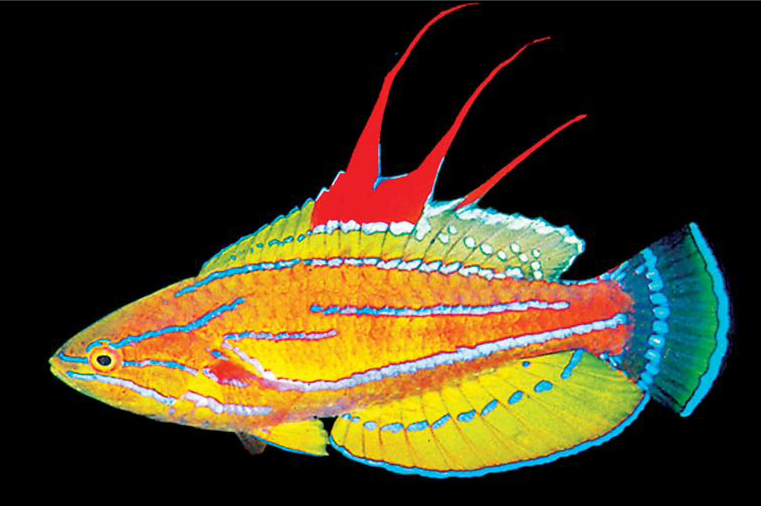- Classification
- ACTINOPTERYGII
- PERCIFORMES
- LABRIDAE
- Paracheilinus
- flavianalis
Yellowfin Flasher Wrasse, Paracheilinus flavianalis Kuiter & Allen 1999

A male (Terminal Phase) Yellowfin Flasher Wrasse, Paracheilinus flavianalis, in Bali, Indonesia (approx 60 mm SL) - showing male-nuptial display. Source: Rudie H. Kuiter in Allen, Erdmann & Yusmalinda (2016) Journal of the Ocean Science Foundation 19: 18–90. License: CC BY Attribution
Females are reddish with violet stripes and no elongated dorsal-fin ray.
Yellowfin Flasher Wrasse, Paracheilinus flavianalis Kuiter & Allen 1999
More Info
|
Distribution |
Offshore reefs of north Western Australia (Scott, Seringapatam, and Hibernia reefs), Ashmore Reef in the Timor Sea, and Evans and Flinders Shoals, Timor Sea, off northeast Darwin, Northern Territory. Elsewhere the species occurs in southern and eastern Indonesia, from Bali eastwards across the Lesser Sunda Islands, southern Sulawesi, the Moluccas.and West Papua; also in Timor Leste. Inhabits rubble or weedy areas on outer reef slopes, often near the base of seaward slopes. Small groups with numerous females, juveniles and several males are usually seen. Small juveniles are secretive. |
|
Features |
Dorsal fin IX, 11; Anal fin III, 9; Pectoral fin 14; Lateral line (pored scales) 14-17 + 5-10 = 19-27; Gill rakers first arch (total) 4-6 + 7-10=+ 11-16; median predorsal scales 5; scale rows on cheek 2. Body depth 3.1–3.5 in SL. Terminal phase males usually with first 2-3 soft rays of dorsal fin forming a single filamentous extension, and third soft ray sometimes produced into ta second filament; longest dorsal-fin soft ray 1.8–3.6 in SL; pelvic fin length 1.9–2.9 in HL; caudal fin of TP males round without filamentous lobes; caudal-fin length 3.8–4.4 in SL. |
|
Size |
In Australia, it occurs in , and Ashmore, Scott, Seringapatam, and Hibernia Reefs in the north-western shelf of Western Australia |
|
Colour |
Terminal Phase males with 1–4 (usually one) elongate, red filamentous dorsal-fin rays, anal fin uniformly yellow or orangey yellow, basal third usually lined with a horizontal row of blue spots (sometimes incomplete or completely absent). |
|
Biology |
Protogynous hermaphrodite. All individuals start life as females, and the dominant female may change sex into a male during her life cycle. This transformation from female to male may take a couple of weeks. Flasherwrasses are broadcast spawners, releasing eggs and sperm into the water column. |
|
Etymology |
The specific name flavianalis is from the Latin flavus (= yellow) and analis (= anal), in reference to the characteristic colour of the anal fin, which separates it from its nearest relative. |
|
Species Citation |
Paracheilinus flavianalis Kuiter & Allen 1999, aqua, Journal of Ichthyology and Aquatic Biology 3(3): 123, figs 4-7. Type locality: Scott Reef, Western Australia. |
|
Author |
Bray, D.J. 2023 |
|
Resources |
Yellowfin Flasher Wrasse, Paracheilinus flavianalis Kuiter & Allen 1999
References
Allen, G.R. 1974. A review of the labrid genus Paracheilinus, with the description of a new species from Melanesia. Pacific Science 28(4): 449-455.
Allen, G.R. 1996. New records of reef and shore fishes from northwestern Australia. Records of the Western Australian Museum 18: 109-112 (as Paracheilinus maccoskeri)
Allen, G.R. & Erdmann, M.V. 2012.Reef fishes of the East Indies. Perth : Tropical Reef Research 3 vols, 1260 pp.
Allen, G.R., M.V. Erdmann & N.L.A. Yusmalinda. 2013. Paracheilinus rennyae, a new species of flasherwrasse (Perciformes: Labridae) from southern Indonesia. aqua, International Journal of Ichthyology 19(4): 193-206. https://doi.org/10.5281/zenodo.46267
Allen, G.R., Erdmann, M.V. & Yusmalinda, N.L.A. 2016. Review of the Indo-Pacific Flasherwrasses of the genus Paracheilinus (Perciformes: Labridae), with descriptions of three new species. Journal of the Ocean Science Foundation 19: 18–90. https://doi.org/10.5281/zenodo.46267
Hutchins, J.B. 2001. Biodiversity of shallow reef fish assemblages in Western Australia using a rapid censusing technique. Records of the Western Australian Museum 20: 247-270
Kuiter, R.H. 2002. Fairy & Rainbow Wrasses and their Relatives. Chorleywood, U.K. : TMC Publishing 207 pp.
Kuiter, R.H. 2010. Labridae fishes: wrasses. Seaford, Victoria, Australia : Aquatic Photographics pp. 398.
Kuiter, R.H. & Allen, G.R. 1999. Descriptions of three new wrasses (Teleostei: Perciformes: Labridae: Paracheilinus) from Indonesia and North-western Australia with evidence of possible hybridisation. aqua, Journal of Ichthyology and Aquatic Biology 3(3): 119-132 figs 1-18
Liu, M. & To, A. 2010. Paracheilinus flavianalis. The IUCN Red List of Threatened Species 2010: e.T187635A8586602. http://dx.doi.org/10.2305/IUCN.UK.2010-4.RLTS.T187635A8586602.en. Downloaded on 22 February 2016.
Moore, G. & Morrison, S. 2009. Fishes of three North West Shelf atolls off Western Australia: Mermaid (Rowley Shoals), Scott and Seringapatam Reefs. Records of the Western Australian Museum, Supplement 77: 221-255
Moore, G.I., Morrison, S.M., Hutchins, B.J., Allen, G.R. & Sampey, A. 2014. Kimberley marine biota. Historical data: fishes. Records of the Western Australian Museum, Supplement 84: 161-206
Tea, Y.-K. & Walsh, F. 2023. Review of Australian species of Paracheilinus Fourmanoir (Teleostei: Labridae), with description of a new species from the Great Barrier Reef and Coral Sea. Ichthyology and Herpetology 111(3): 397-415. https://doi.org/10.1643/i202301






